
The Rest of
the Story
Japan bombs mainland
USA! Army Air Corps becomes Army Air Forces, The Americans. Interesting,
inspiring, unusual stories generally like Paul Harvey's "The
Rest of the Story."

|
|
The Strange
tale of theJapanese Motor Vessel
MV
Awa Maru
The following
is from Wikipedia "The Awa Maru was a Japanese
ocean liner owned by Nippon Yusen Kaisha.
|
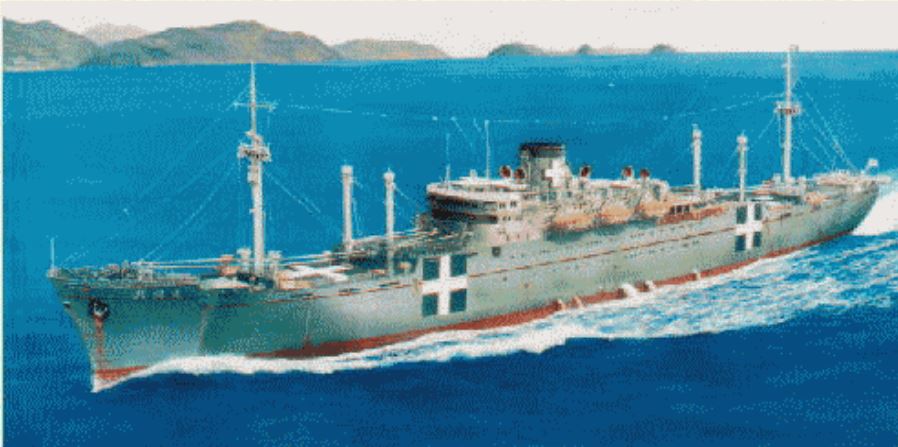
The Awa Maru
Click
image for larger view
|
|
The ship
was built in 1941–1943 by Mitsubishi Shipbuilding
& Engineering Co. at Nagasaki, Japan. The vessel
was designed for passenger service, but the onset of
war by the time work was completed changed requirements,
and she was requisitioned by the Japanese Navy. While
sailing as a hospital ship under the protection of the
Red Cross in 1945, she was torpedoed by USS Queenfish
(SS-393), killing all but one of 2,004 people aboard."
This
was generally believed and has been repeated many times
in other publications. But this is before THE
REST OF THE STORY!
Click
the star for The Rest of The Story
from one who was there!
A
guest first hand report from Sharkhunters!
|
|
|
|

|

Updated 03/24/2013
1 November 1950
The young Catholic Chaplain, now wide awake, was busily
running from foxhole to berm dragging wounded back and
saying prayers over the dying, hearing confessions under
fire, all the while dressing wounds. Men screamed at
him to run, but he ignored them. "I'm going to
give you guys the last rites," he said "because
a lot of you guys are not going to make it home."
He called out the sacred words in English, not Latin.
He has been awarded the Medal of Honor and is one step
away from sainthood. Just one more forgotten hero of
the forgotten Korean war!
Click
the Star
|
|
|
|
The
Doolittle Raid and
Sweetheart Wings
A
moving and unknown sidebar to the well known story!
|  |
Click
the star for details and for The Rest of The Story
|
|
Also
the SS America, a sad ending . . .
USS
WestPoint
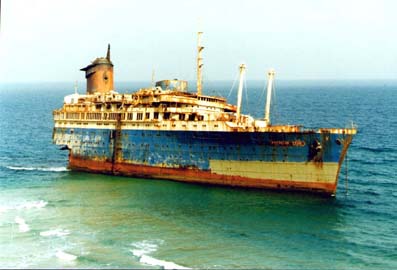
This
Photo shows the "ss America, uss Westpoint, ss America,
ss
Australis, ss America, Italis, Alferdoss, Noga, and American
Star" as she was in 1994. This picture of her along with
a
complete history can be found at the web
site by
Darren Byrne. It is a sad but beautiful site!
Well worth a visit whether or not you served aboard her.
http://www.ss-australis.com/
http://en.wikipedia.org/wiki/SS_America_%281940%29
"From
the Cradle to the Grave"
|
Sgt Joe
Tillery wrote
I don't
really have enough personal identification with the
SS America to submit anything of interest other than
the fact that I crossed the North Atlantic in the dead
of winter. We had only two meals a day and we stood
in line most of the day for those two meals. The cabins
and all the 1st class area was "Officers Country"
but I was able to peek in a little from my KP station
.I guess I was so very impressed with how beautiful
it was how large it was that I tried to keep up with
her. As you will see, the old girl came to a tragic
end but better than being scraped.
|
Editor's
Note:
This wonderful luxury liner, the
SS America, was the first liner to have her interior
designed by women to be warm, comfortable, and friendly
unlike the stodgy, stuffy designs before her. She
was sponsored by Eleanor Roosevelt herself but her
career as a top luxury liner in the lucrative north
Atlantic route was cut very short. As the war stirred
up in Europe, her beautiful hull was painted with
huge American flags to deter U-boat attacks and
she started sailing further south. But like her brothers
and sisters in America,
|
|
and while sitting at Saint
Thomas she was abruptly ordered to return. She was
drafted in May, 1941 and became the USS Westpoint
(AP 23.) She remained a transport until 1946. She
briefly became the SS America after the war but was
sold and became the SS Australis in 1964. She became,
in turn, SS Italis, SS Noga, and SS Alferdoss and
the SS American Star.
While still the SS America, in 1941, she had a chief
butcher called Franz Stigler and a crew member named
Erwin Siegler. They were both Nazi spies collecting
information especially about the Panama Canal and
as couriers for other spies. They were uncovered by
the FBI shortly after her induction and convicted.
Stigler was sentenced to serve 16 years in prison
on espionage charges with two concurrent years for
registration violations. Siegler was sentenced to
10 years imprisonment on espionage charges and a concurrent
two-year term for violation of the Foreign Agents
Registration Act.
She was sold the last time to
be a 5-star hotel ship off Phuket, Thailand. She was
refitted for that purpose and began being towed by
a seagoing tug to Thailand. Apparently unhappy with
her fait, she broke her tow lines in a storm. Attempts
to reattach were unsuccessful so she was left adrift
to finally come aground in the Canary Islands.
On the shore, pounded by waves
throughout 2007 she slowly broke up and disappeared
under water. In 2008 only the tip of her shapely bow
remained in site.
|
|
|
|
The
Magnificent C-47
A
SIGHTING!
Another WWII Sighting of Kilroy Was Here
Click
the star for details and for The Rest of The Story
|
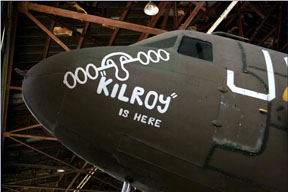
Image
thanks to David Dunham Fine Art
This
is not the original Kilroy is Here. See curator's explanation.
Click image for larger view
|
|
|
|
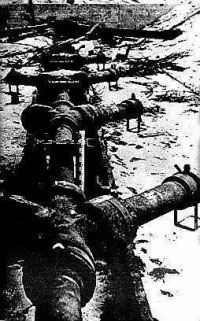
Angled T-joints
Image thanks to The
Century of flight
|
The largest cannon ever built
The LONDON GUN
In
July 1944 Hitler tried to keep a promise to the German
people. He promised over and over that his secret weapons
would, at last, turn the tide and Germany would win.
To do it he authorized the building of what was at that
time the most potentially devastating weapon of the
war – THE LONDON GUN! It was also known as the
V3 Cannon after the V1 Buzz Bomb and the V2 Rocket.
These massive long range cannons had already been test
fired in a remote Baltic sea location. They were big
at 460 feet long. Timed explosions along the length
of the barrel at angled T-junctions bumped the shell
a little faster with each explosion as it proceeded
along the barrel. This resulted in a muzzle velocity
of over 1500mps (4,921 ft/sec) for a 140kg (308 lb.)
shell. They could lob this shell more than 100 miles.
By comparison, USS Missouri's 16" guns could fire
about 20 miles depending on the type shell. So far,
it was the largest gun ever built. Fifty of these guns
along the coast of France sitting just across the channel
near the port of
|
Calais would lob some six hundred
shells PER HOUR into London every day.
Soon some five thousand engineers and
workers (many slave) descended upon a small French town, Mimoyecques,
just inland from Calais to build the first battery. These
gun emplacements would have concrete and steel roofs 100 feet
thick. Only the muzzles would protrude above ground but even
they would have 8-inch sliding steel doors covering them until
firing. They had their own rail line, their own storage facilities,
and elevators to lift the huge shells to the breach. There
were to be 25 guns in this, the first battery.
| But the French underground
soon spotted strange activity near the hamlet. They sent
word quickly to British Intelligence. With this and other
vital information, they soon deduced the activity and
construction was for the LONDON GUN. But what could they
do about it? It was built hundreds of feet underground.
In late 1943 there was a plan hatched by the Americans
and British to deal with the GUN. This plan, in addition
to regular conventional and "penetrating bombs,"
was very dangerous and had never been done before by the
Allies although the Germans had successfully used similar,
if smaller, radio-controlled drones - see Nazi
Smart Bombs. It involved an aircraft filled with
explosives to be flown by pilots to a point near the target
then flown into the construction by another following
behind with radio guidance equipment. One young American
Lieutenant named Joseph Patrick volunteered to command
the drone until it was ready to attack. It was a B-24
Liberator that had a normal payload of 2,700 to 8,000
pounds. They removed the guns, ammo, crew (except for
Joseph Patrick and his copilot) and everything else not
nailed down. They loaded it with some 22,000 pounds of
high explosives. |
|
In November 1944, Joseph Patrick and his
copilot struggled off from a base in Southern England. They
were followed quickly by the another Liberator. The plan was
to get the overloaded B-24 near Mimoyecques where Joe Patrick
and his copilot would bail out over enemy territory, making
it very likely that they would spend the rest of the war as
guests of the Germans – if they survived. The second
Liberator using primitive remote control equipment would guide
the now unmanned flying bomb into the LONDON GUN being built.
Shortly after takeoff something went very
wrong! Something, perhaps a spark from the radio remote control,
ignited the 22,000 pounds of high explosives which exploded
over southern England. The blast was so huge that no remains
of Joseph Patrick nor his copilot were ever found. To this
day, results of the inquiry have never been released . . .
if indeed there were results. We don't know why the Liberator
exploded.
|
|
Although the LONDON GUN never fired a shot, it inexorably
affected US history, Cuban History, and SE Asian history
in ways we will never know. As interesting as the story
of the LONDON GUN is, it isn't the most important part
of the story. Continue below for, as Paul Harvey says,
"The Rest of the Story."
For "The Rest
of the Story" Continue reading below

|
|
"The
Rest of the Story*"
The London
Gun
You see,
the young lieutenant named Joseph Patrick had the
last name of Kennedy. He was the oldest son of Joe
Kennedy, the former ambassador to England and a
crony of the wartime President Roosevelt. His father
and FDR were grooming Joseph Patrick, known to all
as Joe, to be president. He would, after the war,
come home as a hero and possibly a former POW. If
he had his younger brother Jack's charm, he would
certainly have beaten Nixon in 1960 instead.
Had he lived and become president, would President
JOE Kennedy abandon the Bay of Pigs invasion that
might have lead to Castro's downfall in 1961? Would
President JOE Kennedy escalate the war in Viet Nam?
And finally, would President JOE Kennedy feel the
need to shore up his political position with a visit
to Dallas in November 1963?
|
|
|
|
One more final, bitter,
irony
Before Joseph Patrick Kennedy's
abortive attempt, massive bombings of the site
using conventional bombs continued to no avail.
Then they used huge 5400kg (5.95 ton) "Tallboy
Penetrator" bombs but they too failed to
damage the construction until 6 July 1944 (4 months
before the loss of Kennedy) when by sheer luck,
one found its way into one of the shaft openings.
It exploded 100 feet below the surface killing
dozens. Work was then abandoned. Allied planners
did not know this so the attempt by Joseph Patrick
Kennedy went on as planned. They died never knowing
that their sacrifice was not even needed!
|
References and more reading
|
| |
|
Three spent cartridges
in the flag
This
Rest of the Story was inspired by the funeral of a
lost friend and distant relative Sgt.
Paul Tillery. Paul contributed to his country
in the almost forgotten, most vicious battle of the
Pacific war . . . the battle of Driniumor River. In
spite of living through such a experience, Paul was
always there to help anyone until he could no longer.
Many people will remember Paul as the angel who helped
them find their loved one's life story both personally
and with his writings.
|
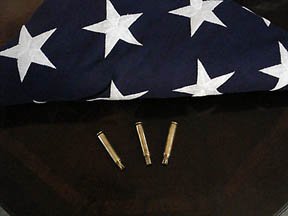 Click
the image for a larger view
Click
the image for a larger view |
A military funeral is a very moving
event. While a casket draped with an American flag sits silently
in front of the mourners and as the mournful refrain of taps
is played by a nearby bugle, three volleys are heard from a
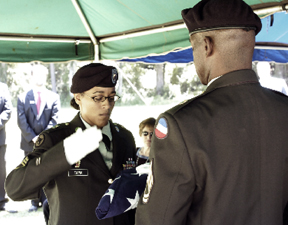 |
firing
squad in the distance. The three volleys fired
over the casket have become a tradition to mean that
the dead have been cared for. Firing the three volleys
over the casket is one of the highest honors to give
a deceased military veteran. After the volley, some
smartly dressed military personnel carefully fold the
flag (traditionally triangular) and present it to the
next of kin with these words: "On behalf
of the President of the United States, please accept
this flag as a symbol of your loved one's honored and
faithful service to this country.".
At some point the flag folders
slip three spent cartridges into the flag never to be
seen again. These are often from the shots
|
fired during the ceremony but not
always. It is not important if they come from this volley but
it is important that they be there. The flag can never be opened
but it is important to the ceremony and tradition that these
spent cartridges be there. Why? Why is it important if the flag
is never to be opened? They will never be seen. The practice
of firing three rifle volleys over the grave originated in the
old custom of halting the fighting to remove the dead and wounded
from the battlefield. Once each army had cleared their dead
and wounded, it would fire three volleys to indicate that the
dead had been cared for and that they
|
Note: Some years ago, this
tradition was quietly changed. The cartridges
are no longer secreted in the flag but handed
to the next of kin. The reason? It was decided
that over years the combination of powder and
brass would stain the flag.
|
were ready
to fight again. This has evolved into a military
salute for the deceased who served their country.
Three spent shell casings inside the folded flag
are there to prove now and forevermore that the
deceased and his flag have had proper military honors.
The remaining shell casings from the volley after
the 3 may be presented separately to the next of
kin so that he or she can distribute them to family
or friends. |
|
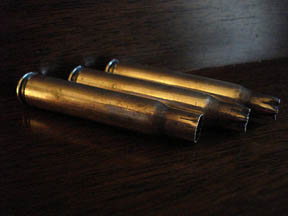 Click
the image for a larger view
Click
the image for a larger view |
|
|
If
the funeral flag and the shell casings are publicly displayed
after the funeral, the box holding the remaining shell
casings should be positioned to the immediate left (the
viewer's right), or directly in front of (but not "on"),
the display case holding the Funeral Flag.
|
The
three spent shell casings represent Duty,
Honor, Country.
For mor information,
see:
http://militarysalute.proboards.com
http://usmilitary.about.com/od/jointservices/a/twentyonegun_2.htm
|
|
|
The Third Anniversary
of a Magnificent Ship's Burial at Sea.
Click
the Star
To see the original story about her burial click
here
|

Awating her fate the night before
the funeral1
|
|
|
|
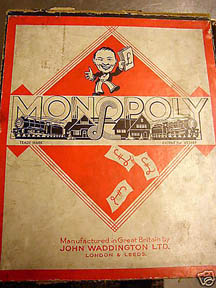
1941 Monopoly Game
|
1 of the most popular board
games of all times
Boardwalk and Park Place go to War
Suggested by Bill Lewis of WOF Productions
Who hasn't played Monopoly? It is
one of the most popular board games of all times and
the best-selling board game in the world. Monopoly is
sold in 103 countries and in 37 languages. Invented
in 1934 by Charles B. Darrow of Germantown PA, it was
first turned down by Parker Brothers Games due to "design
errors." In 1935 they changed their mind and, in
one year Monopoly became the best-selling game
|
in the U.S. But why is Kilroy Was Here,
a site dedicated to the history of WWII and Korea, featuring
a board game?
For "The Rest
of the Story" Click the image or the star ->

|
|
|
The Missionary who saved them
The Rest of the
Doolittle Raid Story
We all have heard of
the daring raid on Tokyo. But have you heard the "Rest
of the Story?"
Click
the Star
|
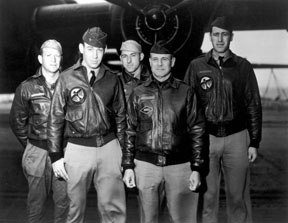
Doolittle's Crew
|
|
|
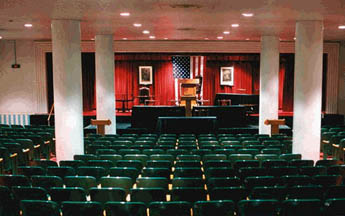 Does this look like the entire US Congress?
Well, in case of nuclear war, this was it!
Does this look like the entire US Congress?
Well, in case of nuclear war, this was it!
| This fall-out
sheltered room would allow the entire Legislative branch
of government to meet after a nuclear exchange. It is
in the (no longer secret) "Bunker" under the
famous 5-star Resort The
Greenbrier. Click the star |
|
|
|
|
"The Japs weren't on Iwo
Jima . . . they were in Iwo Jima"
The Emperor's Reluctant
Warrior
This Japanese General
didn't want a war with America, but he answered the
call from his Emperor. He changed Japanese tactics from
this point on in the war. Did this change actually win
the battle for Iwo Jima?
For Gen.
Kuribayashi's story click the star.

Also read this excerpt
from Trinity
|
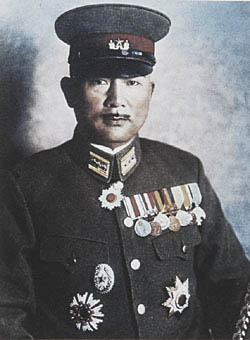
|
|
Suggested
by Col. Norm Gertz, USMC (R) He was there!
|
|
|
". . . the most horrible
campaigns in the history of man"
An Invasion
not Found in the History Books
The Planned invasion of Japan
|
|
Ever wondered how the Pacific
war would have ended if not for the atomic bombs? Well, here's
an answer. The plans for Operation Downfall have been pulled
from the archives. It would have been "the most horrible
campaigns in the history of man." General Douglas MacArthur
estimated American casualties would be one million men by
the fall of 1946. One million young men of the "Greatest
Generation" wouldn't have come home to build the greatest
nation ever known.
But what about Japan? "Japan
today could be divided much like Korea" "The
cost in human life that resulted from the two atomic blasts
would be small in comparison to the total number of Japanese
lives that would have been lost by this aerial devastation."
Don't miss this story! It has
been hidden away in the archives for decades.
Click the star . . . 
Suggested
by Tom Kercher, Florida 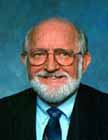
|
|
|
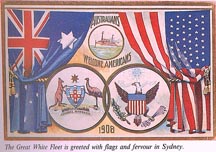
Masonic emblem of U.S.-Australian friendship from 1908.
Click for a larger view
|
Why I love America
A Day Brightener
David Cooper, a mate
from Australia, remembers a terrifying time in Australia
when their army was in Europe fighting for England and
Japanese forces threatened a brutal invasion. Then the
Americans came. Click the star for the story.

|
|
|
|
USS Oriskany's
BURIAL AT SEA
This beautiful, magnificent,
corpse will "lie in state" at the municipal
pier in Pensacola Florida until it's "burial at
sea" some 22.5 miles offshore. Watch here for details!
Click the star for the story. 
|
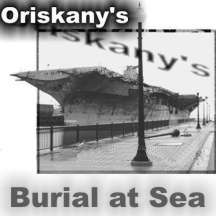
|
|
|
|
Hero's
son heard a different drummer
What
Happened to Hero's Son?
Eric Shackle sets out to find the
beautiful child that his wife, Jerry knew in Australia
in 1942. The youngster disappeared after his father,
General Douglas MacArthur, returned to the US from another
war in Korea
|
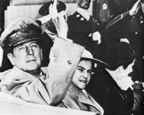
General MacArthur, Arthur MacArthur
IV, and Jean. American Caesar, Little, Brown and Co.,
1978
Click Image
for larger view
|
|
|
The Army Air Corps
became the Army Air Forces on June 20, 1941, six months before
Pearl Harbor.
This seems to be universally unknown. As you can see from
the poll results below, the answer least selected was, actually
the correct one. I have spoken to many who served in the Army
Air Forces during WWII who still believed they were in the
Army Air Corps. Why is, perhaps, stated best by Wikipedia
"World War II Air Corps personnel
had a strong sentimental attachment to their branch. The Air
Corps had an aura about it that seemed to set it apart from
other Army branches. Now, sixty years later, many WW II servicemen
still proudly identify themselves as veterans of the Air Corps.
However -- although the Air Corps was their branch -- they
actually served and fought in the Army Air Forces! "
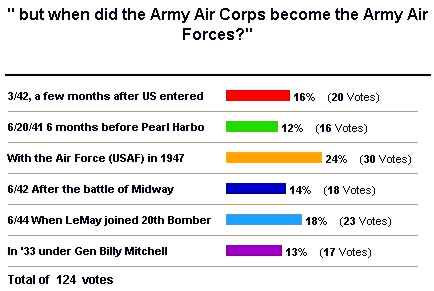
My thanks to the The
Army Air Forces Historical Association who's excellent
site gives details and the history behind the move.
|
|
The One Dollar Bill Explained
.
The Dollar
Bill
|

Click any picture
for a full size view
|
Take out a one dollar bill
(older version) and look at it. The one dollar bill you're
looking at first came off the presses in 1957 in its present
design. This so-called paper money is in fact a cotton and
linen blend, with red and blue minute silk fibers running
through it. It is actually material. We've all washed it
without it falling
apart. A special blend of ink is used, the contents we will
never know. It is overprinted with symbols and then it is
starched to make it water resistant and pressed to give
it that nice crisp look.
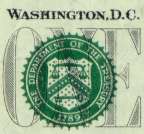 If
you look on the front of the bill, you will see the United
States Treasury Seal. On the top you will see the scales
for the balance - a balanced budget. In the center you have
a carpenter's T-square, a tool used for an even cut. Underneath
is the Key to the United States Treasury. If
you look on the front of the bill, you will see the United
States Treasury Seal. On the top you will see the scales
for the balance - a balanced budget. In the center you have
a carpenter's T-square, a tool used for an even cut. Underneath
is the Key to the United States Treasury.
That's all pretty easy to figure out,
but what is on the back of that dollar bill is something
we should all know. If you turn the bill over, you will
see two circles. Both circles, together, comprise the Great
Seal of the United States. The First Continental Congress
requested that Benjamin Franklin and a group of men come
up with a Seal. It took them four years to
| accomplish this task
and another two years to get it approved. If you look
at the left hand circle, you will see a Pyramid. Notice
the face is lighted and the western side is dark. This
country was just beginning. We had not begun to explore
the West or decided what we could do for Western |
|
Civilization. The Pyramid is uncapped,
again signifying that we were not even close to being finished.
Inside the capstone you have the all-seeing eye, and ancient
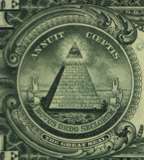 symbol
for divinity. It was Franklin's belief that one man couldn't
do it alone, but a group of men, with the help of God, could
do anything. "IN GOD WE TRUST" is on this currency.
The Latin above the pyramid, ANNUIT COEPTIS, means "God
has favored our undertaking." The Latin below the pyramid,
NOVUS ORDO SECLORUM, means "a new order has begun."
At the base of the pyramid is the Roman Numeral for 1776. symbol
for divinity. It was Franklin's belief that one man couldn't
do it alone, but a group of men, with the help of God, could
do anything. "IN GOD WE TRUST" is on this currency.
The Latin above the pyramid, ANNUIT COEPTIS, means "God
has favored our undertaking." The Latin below the pyramid,
NOVUS ORDO SECLORUM, means "a new order has begun."
At the base of the pyramid is the Roman Numeral for 1776.
If you look at the right-hand circle,
and check it carefully, you will learn that it is on every
National Cemetery in the United States. It is also on the
Parade of Flags Walkway at the Bushnell, Florida National
Cemetery and is the centerpiece of most hero's monuments.
Slightly modified, it is the seal of the President of the
United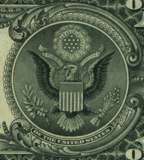
States and it is always visible whenever he speaks, yet
no one knows what the symbols mean. The Bald Eagle was selected
as a symbol for victory for two reasons: first, he is not
afraid of a storm; he is strong and he is smart enough to
soar above it. Secondly, he wears no material crown. We
had just broken from the King of England. Also, notice the
shield is unsupported. This country can now stand on its
own. At the top of that shield you have a white bar signifying
congress, a unifying factor. We were coming together as
one nation. In the Eagle's beak you will read, "E PLURIBUS
UNUM", meaning "one nation from many people."
Above the Eagle you have thirteen stars representing the
thirteen original colonies, and any clouds of misunderstanding
rolling away. Again, we were coming together as one. Notice
what the Eagle holds in his talons. He holds an olive branch
and arrows. This country wants peace, out we will never
be afraid to fight to preserve peace. The Eagle always wants
to face the olive branch, but in time of war, his gaze turns
toward the arrows.
They say that the number 13 is an unlucky
number. This is almost a worldwide belief. You will usually
never see a room numbered 13, or any hotels or motels with
a 13th floor. But, think about this: 13 original colonies,
13 signers of the Declaration of Independence, 13 stripes
on our flag, 13 steps on the Pyramid, 13 letters in the
Latin above, 13 letters in "E Pluribus Unum ",
13 stars above the Eagle, 13 plumes of feathers on each
span of the Eagle's wing, 13 bars on that shield, 13 leaves
on the olive branch, 13 fruits, and if you look closely,
13 arrows. And for minorities: the 13th Amendment. I always
ask people, "Why don't you know this?" Your children
don't know this and their history teachers don't know this.
Too many veterans have given up too much to ever let the
meaning fade. Many veterans remember coming home to an America
that didn't care. Too many veterans never came home at all. ",
13 stars above the Eagle, 13 plumes of feathers on each
span of the Eagle's wing, 13 bars on that shield, 13 leaves
on the olive branch, 13 fruits, and if you look closely,
13 arrows. And for minorities: the 13th Amendment. I always
ask people, "Why don't you know this?" Your children
don't know this and their history teachers don't know this.
Too many veterans have given up too much to ever let the
meaning fade. Many veterans remember coming home to an America
that didn't care. Too many veterans never came home at all.
Author unknown (if you know,
please email me)
Thanks to Tom Kercher, Florida
|
|
|
The
largest airborne operation in history!
Operation
Market Garden
Operation
Market Garden was as an attempt to free occupied Holland
in September 1944. It was billed as the largest airborne
operation in history (see sidebar Quizlet Results).
But don't
take my word for it. Read a translation
|
Quizlet
Results
What
was Operation Market Garden? It was a an attempt to
liberate the Netherlands in September 1944. Had it
succeeded, the war might have ended months before
it did. As to the answer that it was the largest airborne
attack in history, there was a little trap here. It
was billed as "The largest Airborne operation
in history." Operation Varsity landings in Northern
Germany (March 1945) were also billed as the largest
airborne operation in history. It is possible that
they were both correct. Operation Market Garden was
the largest up to then and Operation Varsity perhaps
broke the record six months later.
There were 295 respondents in 2 weeks.
1. Attempt to liberate occupied Holland ----------
56%
2. Largest airborne attack in history. ---------------
26%
3. MI-6 try to destabilize Nazi Government-------
05%
4. Escape Attempt from Stalag 43 - Poland------- 05%
5. Attempt by US spies to assassinate Hitler-----08%
|
from a web site in the Netherlands discussing
it. Thanks to Jeroen Cornelissen for this translation of the
Operation Market Garden web site. At the end of his translation,
he gives the address of this and another, the Wings
of Liberation Museum (in English) for more information.
Click
here for the translated web site
|

|
The mainland US has
never been bombed from an enemy aircraft . . . Wrong!
|

| |
|
|
A special July
4th Message
by Robert Pappas
Editor's note: Robert is a retired
US Marine Colonel who flew two combat tours in Viet Nam. He
was shot down over enemy territory once, but evaded capture
by ejecting out to sea. He earned the Purple Heart, Navy Commendation
Medal, Meritorious Service Medal, Bronze Star, Air Medal (26)
and two stars, Distinguished Flying Cross (2) and the Legion
of Merit (2). (He insists on adding an old saying, "It's
not what we get, but what we give that measures the worth
of the life we live.")
After retirement he became Regional Director
of Banking and Finance, Northwest Florida Region with offices
in Pensacola, in 1995; Acting District Administrator, District
10, Department of Children and Families in Fort Lauderdale,
Florida; and Regional Director of Banking and Finance, Southwest
Florida Region with offices in Fort Myers, in December 1999.
Click here to read Robert's message
|
| |
|
|

O'Hare Airport
and the WWII connection
During the course of
World War II, many people gained fame in one way
or another. One of these was Butch O'Hare, a fighter
pilot assigned to an aircraft carrier in the Pacific.
On one occasion his entire squadron was assigned
to fly a particular mission. After O'Hare was airborne,
he looked at his fuel gauge and realized that someone
had forgotten to top off his fuel tank. Because
of this, he would not have enough fuel to complete
his mission and get back to his ship. His flight
leader told him to leave formation and return.
As he was returning to the mother ship, O'Hare could
see a squadron of Japanese Zeroes heading toward
the fleet to attack. With all the fighter planes
gone, the fleet was almost defenseless, his was
the only opportunity to distract and divert them.
Single-handedly, he dove into the formation of Japanese
planes and attacked them. Butch dove at them and
shot until all his ammunition was gone, then he
would dive and try to clip off a wing or tail or
anything that would make the enemy planes unfit
to fly. He did anything he could to keep them from
reaching the American ships. Finally, the Japanese
squadron took off in another direction, and Butch
O'Hare and his fighter, both badly shot up, limped
back to the carrier. The American fighter planes
were rigged with cameras, so that as they flew and
fought, pictures were taken so pilots could learn
more about the terrain, enemy maneuvers, etc. So,
even though O'Hare told his story, it was not until
the film from the camera on his plane was developed,
that they realized the extent he really went to,
to protect his fleet. He was recognized as a hero
and given one of the nation's highest military honors.
O'Hare Airport in Chicago was later named after
him.
And now, as Paul Harvey says, the Rest of the
Story!
During the gangster era,
in Chicago, there was a man called Easy Eddie. He
was working for a man you've all heard about: Al
Capone. Al Capone wasn't famous for anything heroic,
but he was notorious for the murders and crimes
he'd committed. Easy Eddie was Al Capone's lawyer,
and a very good one. In fact, because of his skill,
he was able to keep Al Capone out of jail. To show
his appreciation, Al Capone paid him very well.
He not only earned big money, he would get extra
things, like a residence that filled an entire Chicago
city block. The house was fenced, and he had live-in
help and all of the conveniences of the day.
Easy Eddie had a son.
He loved his son and gave him all the best things
while he was growing up: clothes, cars, and a good
education. And, because he loved his son he tried
to teach him right from wrong. But one thing he
couldn't give his son was a good name, nor could
he be a good example. Easy Eddie decided that this
was much more important than all the riches he had
given his son. So, he went to the authorities in
order to rectify the wrong he had done. It meant
he must testify against Al Capone, and he knew that
Al Capone would do his best to have him killed.
But, he wanted most of all to try to be an example
and to do the best he could to give back to his
son a good name. So, he testified. Within the year,
he was shot and killed on a lonely street in Chicago.
|
|
Do
these stories seem unrelated . . . ? Butch O'Hare was
Easy Eddie's son.
Thanks
to John W. Greenley
This is not completely true according to Snopes. Thanks to Terry
Hostetter. See her letter at:
"It's
still a good story even if it isn't all true"
|

The first time the haunting, sad Taps
was played
This story has
been debunked. Please read to the bottom!
It all began in 1862 during the
Civil War when Union Captain Robert Ellicombe was with his
men near Harrison's Landing in Virginia. The Confederate army
was on the other side of the narrow strip of land. During
the night Captain Ellicombe heard the moan of a soldier who
lay mortally wounded on the field. Not knowing if it was a
Union or Confederate soldier the Captain decided to risk his
life and bring the stricken man back for medical attention.
Crawling on his stomach through the gunfire the Captain reached
the stricken soldier and began pulling him toward his encampment.
When the Captain finally reached his own lines he discovered
it was actually a Confederate soldier but the soldier was
dead. The Captain lit a lantern. Suddenly he caught his breath
and went numb with shock. In the dim light he saw the face
of the soldier. It was his son. The boy had been studying
music in the south when the war broke out. Without telling
his father, he enlisted in the Confederate Army.
The following morning, heartbroken, the father asked permission
of his superiors to give his son a full military burial despite
his enemy status. His request was partially granted. The Captain
had asked if he could have a group or Army band members play
a funeral hymn for the son at the funeral. That request was
turned down since the soldier was a Confederate.
Out of respect for the father they did say they could give
him only one musician. The Captain chose a bugler. He asked
the bugler to play a series of musical notes he had found
on a piece of paper in the pocket on his dead son's uniform.
This wish was granted.
This music was the haunting melody we now know as "Taps"
that is used at all military funerals.
THESE ARE THE WORDS TO "TAPS"
Day is done
Gone the sun
From the lakes
From the hills
From the sky
All is well
Safely rest
God is nigh
 Thanks
to Tom Kercher, Florida Thanks
to Tom Kercher, Florida
Note from the editor: Since Tom sent
this moving tale of Taps, new information has been received
from Bruce Deeter who wrote:
"I was doing some research on inspirational stories,
actually searching for links on the "Butch O'Hare - Easy
Eddie" story and found your "Rest of the Story"
site. From what I've read a Major General Butterfield is given
credit as the composer. I suggest you check out some of these
links:
http://www.west-point.org/taps/Taps.html
http://www.arlingtoncemetery.com/taps.htm
http://www.arlingtoncemetery.com/tapsproj.htm
http://www.arlingtoncemetery.com/taps-pro2.htm
Sincerely,
Bruce Deeter
To read Bruce's entire letter, see the letters
page.
Another email debunking the Taps story. This
one from Mac Smith. Too bad, it was a beautiful story.
To read Mac's entire letter, see the
letters
page.
|

|
 "The Americans" "The Americans"
---------------------------------------------------
It was June 5, 1973. The United
States had just pulled out of the Vietnamese War which ended
in defeat. It was a war condemned daily on TV, over radio and
in the press. The war had divided the American people. At home
and abroad it seemed everyone was lambasting the United States.
The American president was being investigated and it seemed
that all American institutions were being torn down. It was
a sad time in America. That's why this broadcast was immediately
flashed across the US It was received by a grateful America
-- finally someone with something nice to say about us.
Gordon Sinclair, in his noon-hour
broadcast rose to the defense of the American people. His
voice was heard around the world as no Canadian has before
or since. Years afterwards, his words are repeated over and
over again. They were read into the U. S. Congressional Records
several times. They keep reappearing because they are true
and because it is so unusual for someone to defend America.
I'm proud to repeat them here again
Gordon Sinclair's "The Americans"
- Original Script "LET'S BE PERSONAL" Broadcast
June 5, 1973 CFRB, Toronto, Ontario
Topic: "The Americans"
The United States dollar took another
pounding on German, French and British exchanges this morning,
hitting the lowest point ever known in West Germany. It has
declined there by 41% since 1971 and this Canadian thinks
it is time to speak up for the Americans as the most generous
and possibly the least-appreciated people in all the earth.
As long as sixty years ago, when I first
started to read newspapers, I read of floods on the Yellow
River and the Yangtse. Who rushed in with men and money to
help? The Americans did.
They have helped control floods on the
Nile, the Amazon, the Ganges and the Niger. Today, the rich
bottom land of the Mississippi is under water and no foreign
land has sent a dollar to help. Germany, Japan and, to a lesser
extent, Britain and Italy, were lifted out of the debris of
war by the Americans who poured in billions of dollars and
forgave other billions in debts. None of those countries is
today paying even the interest on its remaining debts to the
United States.
When the franc was in danger of collapsing
in 1956, it was the Americans who propped it up and their
reward was to be insulted and swindled on the streets of Paris.
I was there. I saw it.
When distant cities are hit by earthquakes,
it is the United States that hurries into help... Managua
Nicaragua is one of the most recent examples. So far this
spring, 59 American communities have been flattened by tornadoes.
Nobody has helped.
The Marshall Plan .. the Truman Policy
.. all pumped billions upon billions of dollars into discouraged
countries. Now, newspapers in those countries are writing
about the decadent war-mongering Americans.
I'd like to see one of those countries
that is gloating over the erosion of the United States dollar
build its own airplanes.
Come on... let's hear it! Does any other
country in the world have a plane to equal the Boeing Jumbo
Jet, the Lockheed Tristar or the Douglas DC-10? If so, why
don't they fly them? Why do all international lines except
Russia fly American planes? Why does no other land on earth
even consider putting a man or women on the moon?
You talk about Japanese technocracy and
you get radios. You talk about German technocracy and you
get automobiles. You talk about American technocracy and you
find men on the moon, not once, but several times ... and
safely home again. You talk about scandals and the Americans
put theirs right in the store window for everyone to look
at. Even the draft dodgers are not pursued and hounded. They
are here on our streets, most of them ... unless they are
breaking Canadian laws .. are getting American dollars from
Ma and Pa at home to spend here.
When the Americans get out of this bind
... as they will... who could blame them if they said 'the
hell with the rest of the world'. Let someone else buy the
Israel bonds, Let someone else build or repair foreign dams
or design foreign buildings that won't shake apart in earthquakes.
When the railways of France, Germany
and India were breaking down through age, it was the Americans
who rebuilt them. When the Pennsylvania Railroad and the New
York Central went broke, nobody loaned them an old caboose.
Both are still broke. I can name to you 5,000 times when the
Americans raced to the help of other people in trouble.
Can you name me even one time when someone
else raced to the Americans in trouble? I don't think there
was outside help even during the San Francisco earthquake.
Our neighbors have faced it alone and
I am one Canadian who is damned tired of hearing them kicked
around. They will come out of this thing with their flag high.
And when they do, they are entitled to thumb their nose at
the lands that are gloating over their present troubles.
I hope Canada is not one of these. But
there are many smug, self-righteous Canadians. And finally,
the American Red Cross was told at its 48th Annual meeting
in New Orleans this morning that it was broke.
This year's disasters .. with the year
less than half-over… has taken it all and nobody...but
nobody... has helped.
(c) 1973 BY GORDON SINCLAIR
----------------------------------------------------------------------------
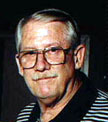 Thanks
to Ray Hildebrand, Florida Thanks
to Ray Hildebrand, Florida
|

Site
Map What's
New Search

Send me your interesting Stories:
WebMaster/Editor


|